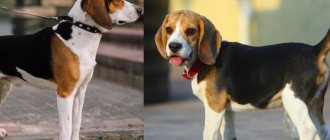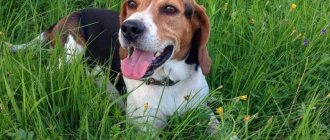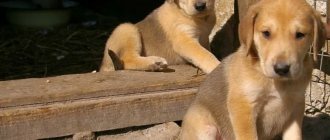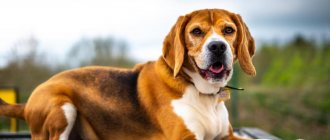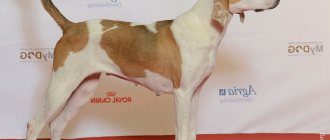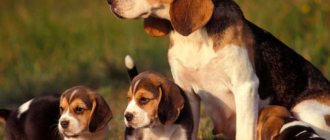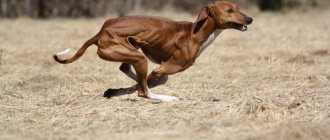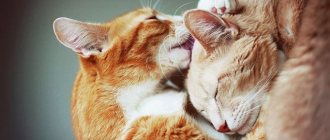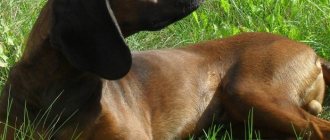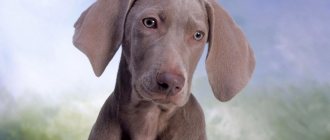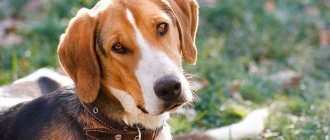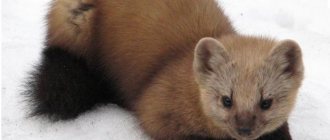Brief historical background
The Estonian hound was bred artificially, the history of its origin is transparent and clear. The reason for the start of breeding work was the state ban on hunting with dogs taller than 45 cm, which was issued in Estonia in the early 30s of the last century, since taller individuals could easily cope with the small number of roe deer, the hunting of which was strictly limited. All hunting dogs available at that time were above the permissible limit, so breeders had to urgently start developing a new breed.
In the formation of the Estonian hound the following were used:
- local aboriginal hunting dogs of short stature;
- Swiss hounds;
- beagles;
- Foxhounds;
- Russian hounds.
The resulting livestock was at first quite diverse, but by 1954 the required result was practically achieved, and the USSR Ministry of Agriculture at a specialized commission recognized the Estonian hounds as a separate breed. Five years later, the first breed standard was developed, then in 1966, 1981 and 2007 some amendments were made to it, and on December 27, 2011, the Russian Canine Federation approved it.
Estonian dog lovers participate in various events to achieve worldwide recognition of the breed.
However, the world canine community does not recognize Estonians, since the proper level of stability of the breed has not yet been achieved and some of its representatives exhibit different traits of the breeds used in breeding. It is listed as unrecognized in the FCI register, but its standard, after approval, has been under review since 1998.
Estonian hounds are most common in the Baltic countries and Russia; they are known very little abroad. Most of the livestock live directly in Estonia.
Video: breeding the Estonian hound and its recognition
Description of the Estonian hound
The standard positions the Estonian hound exclusively as a hunting dog, helping in hunting on foot small animals (fox, hare, etc.) and birds . Hounds work well on the scent. Recently, more and more often they are kept as watchmen and security guards, as well as companion dogs.
Appearance
The Estonian Hound is a small, extremely active and energetic dog with a strong, but elegant, graceful and lean physique with strong solid bones and well-developed, prominent muscles. The body is rectangular in format (extension index for males - 108–110, for females - 110–112) with an extended straight back, well-developed and prominent withers, deep, elongated, oval, sternum dropped to the elbows, convex, wide short loin and moderately toned , raised in the direction of the croup by the underline. Sexual dimorphism is pronounced, females are noticeably smaller and lower.
The physique of the Estonian Hound is dry, graceful and elegant.
Breed standard:
- Height at withers: females - 42–49 cm;
- males - 45–52 cm.
The Estonian hound moves smoothly and elastically, pushing well with its hind legs and swinging its front legs far. All movements are energetic, free and straightforward.
The Estonian's movements are smooth and elastic
The coat is hard and short, evenly fitting the body and shiny with a poorly developed, poor undercoat. On a general white background there are black and colored spots of different sizes (as bright as possible).
Acceptable colors:
- yellow-piebald;
- scarlet-piebald;
- black-and-white;
- brown-piebald with tan;
- black and tan with tan (the most common).
White markings are allowed on the chest, throat, head and belly. The end of the tail and all legs should be white.
The Estonian differs from its direct relative, the beagle, in having a more slender and graceful physique, as well as being taller.
The Beagle is stockier. strong and short-legged
Disadvantages and disqualifying vices
Faults or minor defects are considered to be any deviations from standard breed characteristics; their severity is assessed depending on the degree of manifestation and their impact on the well-being, well-being and health of the animal.
Vices and more serious shortcomings will be:
- body is too long or short;
- raised pelvis;
- flattened or convex skull;
- abnormal pigmentation of the eyelids, lips and nose;
- undershot (small);
- eyes are small or bulging, light iris;
- ears set above the eye line are thick, short or furry;
- pendant around the neck;
- chest sideways, flat or narrow;
- weak back, hunchbacked or sagging;
- a twisted or broken tail, with a large dewlap or sparsely covered with hair;
- improper development of limbs;
- the coat is long or very short, wavy, complete absence of down;
- color that does not correspond to the standard (brown, strong speckling, etc.);
- rough or very light build;
- excessive excitability or timidity.
The grounds for disqualification are:
- too tall;
- problems with the jaws (underbite, overbite);
- blue iris, different eye colors;
- ears erect, raised or very small;
- serious defects in the tail (kinks, tilting to the side, etc.);
- lack of white in color;
- weak sexual dimorphism;
- obvious deviations (physical and mental) from the norm;
- cowardice or aggressiveness.
It is extremely important that the dog behaves adequately at exhibitions and field trials, does not show anger, but does not cling to the owner’s legs. Experts reject such individuals immediately. A good friend of ours had a wonderful hunting dog (drathaar), who would panic and, one might say, go into hysterics (which manifested itself in restlessness and endless barking) as soon as the owner moved far enough away from him.
Character and psyche of the breed
The Estonian Hound has a soft, flexible and good-natured character, as well as a calm and balanced temperament . The dog is endlessly devoted to his owners, especially worshiping one, the most important one, whom he obeys unquestioningly. He is very patient with children, enjoys playing with them, taking an active part in various pranks. But he does not tolerate loneliness well, filling the space with continuous barking. It is better not to get this breed for people who are very busy and often absent from home, so as not to injure the nervous system of the dog and neighbors.
The Estonian Hound gets along well with children of all ages.
A friendly pet will never become a good guard and watchman, since in most cases it perceives strangers very positively, even allowing itself to be petted right away. He can notify household members of the arrival of guests with a joyful bark, but that’s all he can do. He is loyal to other pets because he has a pack history. He can become friends with his cat if he grew up with her. But small animals and neighboring cats remain objects of hunting for him, which he will inevitably chase after as soon as the opportunity arises.
Timely and early socialization will allow you to avoid many problems in communicating with your own kind and strangers.
Energetic, playful and extremely active animals are completely unsuitable for lovers of passive recreation. For these hounds, the best owners will be athletic and active individuals, with whom the pets can get the necessary level of physical activity.
Breed standard
The standard of this breed implies a set of exterior features of a given dog that distinguishes it from other representatives of the canine family, as well as from its immediate relatives - members of the hound group.
Like any other officially recognized breed, the Estonian Hound has its own standards.
Table 1. Estonian Hound breed standard
| Exterior element | Description |
| Body | This dog is of average height, and its body is very strong, muscular and dry. The height of this animal at the withers is: for males 45-52 centimeters; bitches have an average of 42-27 centimeters. Also, these dogs sometimes have a slight high rear, which is attributed to the working shortcomings of the breed, however, it does not matter for home keeping. The skin of these animals is smooth, elastic and does not have any folds over the entire surface of the body. The chest of these dogs is well developed, it is long and deep. The back is straight, with obvious prominent withers. |
| Wool | The color of these representatives of hounds usually corresponds to the standard for the group of breeds in question as a whole: black and piebald, decorated with so-called ruddy spots. The sizes of these spots are not specified by the standard, therefore, they can have any size. In some situations, dogs may exhibit pronounced markings, which is considered not a fault of the breed, but a defect. The coat itself is short, shiny, and hard and smooth. It is especially thick on the tail, so it seems that these animals have a thick tail. |
| Head and neck | The head of representatives of this breed is wide and has a rounded shape. The muzzle is elongated, ending with lips that fit tightly to the jaw and a wide nose of black or dark brown color. The ears of these hounds are hanging, elongated, but have a small thickness. Their landing is low. The ears are covered with short hair. The eyes of the Estonian hound variety are set askew and have a dark brown tint. The neck of Estonian hounds is strong, muscular, and has a rounded shape. |
| Limbs | The front and hind legs of these dogs are very muscular, located parallel to each other and have a straight shape. At the same time, the elbows look back. The paw pads are wide, fleshy, oval-shaped and have tightly clenched toes. The tail of Estonian hounds has the shape of a saber, thickened at the base and gradually becoming narrower towards the tip. |
The Estonian Hound has a saber-shaped tail
Choosing a puppy
The population of Estonian hounds is small, but they can be found in Russia . It is better to purchase a puppy from a reliable breeder or a specialized nursery that has a good reputation and positive reviews.
It is recommended to look for a pet for hunting, which will inherit the innate hunting talents of its parents, from real hunters.
Since Estonian females are quite rare and are not particularly remarkable in appearance, simply visually similar animals are often sold under their guise. It is almost impossible to distinguish an Estonian hound puppy from a beagle puppy or from a baby of an unknown breed, but with a similar appearance. Only relevant authentic documents (pedigrees, field and show diplomas of the parent pair, puppy records, etc.) will be guaranteed.
Estonian hound puppies are easy to find
Price of a puppy of this breed
The cost of a good purebred puppy from a working bitch starts from 30 thousand rubles. The exact amount directly depends on the baby’s prospects, as well as the hunting qualities of the parents. A pet advertised without using it in the future for hunting (just for home, for family) can be found for 5–7 thousand.
Photo gallery
We talked in detail about all the positive and negative aspects associated with the use of Estonian hounds in hunting. And now we offer you a small selection of photos for viewing.
Caring for the Estonian Hound
Estonian women adapt equally well to life in an apartment and in a country house . In the first option, they need to be walked at least twice a day for an hour and a half, giving them the opportunity to run and frolic. In the second case, you will need to install a good and durable fence around the yard or enclosure, because hounds jump very well, despite their small stature, and also dig tunnels passionately and skillfully. Dogs cannot be kept outdoors all year round, because their fur is short and does not provide warmth. During the cold season, animals are transferred to a heated room.
Basic care is as follows:
- for short fur, it is enough to comb it once a week with a special brush or silicone mitt to remove dead hair (daily during the molting period);
- bathe 1-2 times a year with zoo shampoo for short-haired animals;
- wipe the eyes with tea leaves or herbal decoction every 3–5 days;
- Ears are examined weekly and cleaned using veterinary lotion;
- once every 5–7 days, use a brush (finger attachment) and special toothpaste for animals to clean their teeth;
- The claws are trimmed with a nail clipper about once a month (if they do not grind down on their own).
It can get boring in a hound's apartment
Estonians are not picky when it comes to nutrition; they can be given both homemade food prepared especially for them, and ready-made store-bought freeze-dried formulations intended for active dogs of medium build. Adults are fed twice a day, puppies are given food from 3 to 6 times depending on their age.
The natural diet includes the following products:
- raw lean meat (horse meat, rabbit, etc.);
- offal, entrails, trimmings, cartilage;
- vegetables, greens;
- boiled fish;
- fruits, berries;
- porridge (rolled oats, rice, yachka, etc.);
- eggs;
- fermented milk products (cottage cheese, fermented baked milk, yogurt, etc.) with low fat content;
- unrefined vegetable oil;
- vitamin and mineral supplements.
It is forbidden to feed dogs fatty, smoked, peppered, highly salted and spicy foods, as well as sweets, baked goods, canned food and tubular (chicken) bones.
Training
Smart and quick-witted Estonians are easy to learn and quickly master commands . You need to start raising and training a puppy from the first days of its arrival in the house. Hounds can be stubborn and independent, so only an experienced dog breeder who will be an unquestioned authority for the dog should work with them. It is better for beginners not to get involved with such dogs for now. Basic obedience courses take place at 5–6 months.
The breed is distinguished by its early maturation; some individuals easily earn field diplomas as early as 7–8 months.
Estonian hounds start hunting very early
It is better to entrust further training, as well as training (training) with work in the field, to a professional canine trainer.
Estonian hounds can participate in various dog competitions (agility, freestyle, etc.).
Education and training
The dog is sociable, so it is easy to train. Professional dog trainers will be able to quickly accustom the puppy to the necessary commands. Dogs require a special approach and maintenance in appropriate conditions.
An apartment dog is more difficult to raise than an kennel dog. Puppies need to be socialized starting at 1.5 months. But this approach is needed for dogs who will serve as companions and family pets.
If you plan to use the dog for hunting, then you need to buy an older dog.
Training is inseparable from developing hunting qualities, so the animal must be taken into the field so that it becomes familiar with the terrain of the future hunt. The training will allow you to form strong and strong paws, which is important for driven hunting.
It is important to accustom your dog to the sound of gunfire from an early age. At the same time, they learn basic commands like “sit”, “fu”, “come to me”, “lie down”.
Hunting
The Estonian hound mainly hunts hares, although it is also capable of hunting larger game. Two months before the expected date of hunting, the animal’s diet is adjusted. If you are overweight, the owner must reduce the consumption of proteins and carbohydrates, focusing on dairy products and vegetables. If you don’t have enough weight, then more meat and cereals are added to your diet.
Attitude towards children
Good-natured character and obedience make it possible to keep a dog in a family with children. The Estonian Hound shows tolerance towards children's pranks.
Diseases of the Estonian Hound
Estonians are considered healthy dogs that do not suffer from any congenital genetic diseases. Rarely occurring diseases of the musculoskeletal system (arthritis, articular dysplasia, etc.) are caused by an improper exercise schedule, prolonged hypothermia, excess body weight or errors in diet. Ear problems (otitis) occur with inappropriate care.
These small hounds can live for about 11–13 years, but there are often cases when a dog has crossed the 15-year mark.
